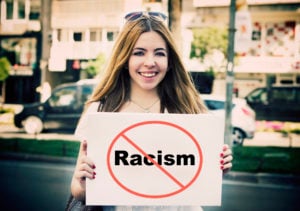
A person with long hair tilts their head and touches their face with one finger, appearing thoughtful.
Thinking about cultural appropriation versus exchange and appreciation can get tricky when considering how it shows up within and across communities of color.
Yes, it’s possible for people of color to appropriate other cultures (not white culture, though, to be clear).
As a person of color, I can absolutely be complicit in cultural appropriation.
For example, when I was in college, I bought a keffiyeh scarf during a study abroad trip because I thought it was “trendy.” However, the keffiyeh scarf is a symbol of Palestinian national identity.
While non-Palestinian activists have worn the scarf as a fashion statement of “solidarity,” this has led to the commodification of the scarf: For some time, you could get a scarf with the keffiyeh pattern from Urban Outfitters – until some folks decided that the scarf pattern was “anti-Semitic” and against pro-Israel movements.
This symbol of national identity is mainly imported from China. When the scarf became “trendy,” Chinese manufacturers drove Palestinian manufacturers out of business. There’s only one manufacturer left.
While I didn’t intend to be hurtful in wearing the scarf, my actions contributed to ongoing practices of disenfranchisement. In addition to enduring human rights violations and being vilified as “terrorists,” Palestinians and those who actually are working in solidarity with them are stigmatized just for wearing this symbol of resistance.
Palestinian hip-hop artist Shadia Mansour’s first single “al-Kūfīyah ʻArabīyah” (“The Keffiyeh Is Arab”) criticized the cultural appropriation of the keffiyeh: “The scarf, they want it; our intellect, they want it; our dignity, they want it / It suits them to steal something that ain’t theirs and claim that it is.”
If I’m going to wear something from another community, not only do I need know what that something symbolizes, but I also need to understand the impact of what it means to wear it, and also where and from whom I’m purchasing it.
Hit the pause button. Is it appropriative for non-Black people, like Shadia Mansour, to perform hip-hop?
Hip-hop is rooted in the struggles, resilience, and survival of Black Americans. So what about ways other people of color, like Mansour, who have used hip-hop as a way to demonstrate dissent against systemic oppression or who have used hip-hop as a platform for identity expression and empowerment? How might Indigenous, Latinx, or Asian American hip-hop artists be different from Macklemore and Iggy Azalea?
Simultaneously, how might we make sense of it when popular hip-hop artists of color appropriate from other communities, such as Nicki Minaj’s Orientalist motifs in some of her music videos? How do we make sense of Selena Gomez sporting a bindi or wearing a sari?
A lot of complicated questions can come up when thinking about what “is” or “isn’t” cultural appropriation. Just because there’s a sense of unity in sharing marginalized racial identities, it doesn’t mean that as a person of color, I get a “pass” when it comes to the appropriation of cultures that aren’t my own.
Because cultural appropriation isn’t just about what you can and can’t do based on your identities, context matters.
Cultural appropriation has often been discussed as when members of a dominant group take elements and symbols from a culture of people that has been systemically oppressed by that dominant group.
And this is true.
And when we’re thinking about ways communities of color might borrow cultural elements from each other, power dynamics are still at play.
Social identities beyond race and ethnicity matter.
While people of color might adopt cultural elements from other communities of color, different contexts – such as religion and spirituality, class, immigration status, and racial hierarchies established by white supremacy – need to be taken into consideration.
So, below are some reasons why people of color might adopt cultures outside of our own communities and ways to negotiate some of these dynamics.
1. Seeking Connection to Other Cultures Due to Lack of Representation of Our Own
Communities of color often lack representation in mainstream culture. I don’t see my identities or experiences represented on TV, in movies, or in music as much as I would like to.
While entertaining, I don’t feel connected to the adventures of the straight, white people I see on shows like Friends and How I Met Your Mother. I also don’t feel very connected to the super sexy depictions of Asian women like Lucy Liu in Ally McBeal or Charlie’s Angels – or the rich aloof entitlement of Brenda Song’s characters in Suite Life of Zach & Cody and The Social Network. I definitely don’t feel connected when I see my racial identity represented as villainous.
I feel disconnected both to White culture and to how my own culture is often represented.
As such, when White culture dominates so much of my reality, I feel drawn to different cultures that work to resist this normalization.
So, I love reading books by authors of color featuring characters of color. I ravenously consume anything by or about Asian Americans across different ethnicities and nationalities just to parse together nuanced narratives. Books like Americanah by Chimamanda Ngozi Adichie or The Book of Unknown Americans by Cristina Henriquez also resonate with me.
I’ve tried to find other cultures that speak to me – where I don’t feel like an outsider.
Yet, just because I don’t feel like an outsider, doesn’t mean that these other cultures belong to me.
Simultaneously, it also doesn’t mean I automatically understand the experiences of these other communities just because I’m adopting aspects of their culture.
Let’s take the case of chef Eddie Huang. He’s talked how hip-hop music has helped him feel less like an outsider. Hip hop felt welcoming to him at times when he felt ostracized by White culture. His story was popularized with NBC’s Fresh Off the Boat, which attempts (to mixed responses) to show how Black culture has been a way for Asian American youth with immigrant parents to negotiate their identity in a “weird” place.
However, while Huang has found a home with hip-hop and has used it as a way to express himself, he’s also attempted to adopt Black oppression.
In an interview with Bill Maher about why hip-hop is so meaningful to him, Huang said: “I feel like Asian men have been emasculated so much in America that we’re basically treated like Black women.”
When he was called out, he responded defensively and rudely, even saying to Mia McKenzie, “Are we dating cause you wildin.”
As an Asian man attempting to reclaim masculinity, Huang has also done so in a way that’s packaged as patriarchal and heterosexist. His responses to critiques have been misogynistic and anti-Black.
As McKenzie tweeted: “Emasculated Asian man appropriates hip-hop and has no respect for Black women.”
Huang can find affinity to hip-hop, but there should be a sense of respect. He shouldn’t trivialize or ignore the racism that Black folks face.
We might feel connected to the look, the sound, the taste, the feel of another culture. It might deeply resonate with us. But we don’t always know the pain. This doesn’t mean we shouldn’t try, but it does mean we don’t get to pretend we experience the exact same struggle.
In this current landscape, there can so much that our communities can offer each other. I’m so grateful to ways so many communities continue to challenge white cultural norms and provided alternative spaces that are energizing and liberating.
It takes bravery, pain, and endurance to maintain our cultures in spaces that are often unwelcoming to us.
Rather than hurt one another by treating these cultural gifts frivolously, we need to think more critically about the ways we engage in each other’s cultural practices.
I’m learning to do better by the people in my life that I love by prioritizing reciprocity when it comes to culture, doing my own research, and knowing limits when it comes to “copying.”
Exchange is about reciprocity – and reciprocity involves ongoing engagement.
At bare minimum, I should be invited by a member of another community to participate in cultural practices. Beyond that, I should have sustained relationships with this community. This is both about consent and having different communities mutually benefit.
2. Global Flows of Culture and Capital
For those of us who belong to diasporic communities or are generations removed from our ethnicities, culture offers a space to connect with concepts of home, family, and identity.
In reaching back to find connections to Taiwan, I look towards cultural elements, like food and entertainment. Culture has been a site for me to discover and express my history and my identities.
I also feel tied to other Asian cultures and notice similarities before I notice differences.
Today, globalization (and particularly the global expansion of capitalism) has expanded the ways in which we can access and connect to other cultures.
K-Pop, Korean dramas, and Japanese anime and manga are mainstream cultural staples. Products stamped with “Made in China” and “Made in Taiwan” are commonplace. South Asian accessories are now deemed fashionable. Pieces of Southeast Asia, from religious relics to street food, are packaged up and distributed around the world.
These different examples are marked with different dynamics. Listening to K-Pop is different than using someone else’s religious music for self-guided meditation. Cosplay is different than wearing a sari.
Again, everything depends on context.
In the Asian diaspora, our histories are tied together and scarred by each other. Every country has experienced colonization and globalization, yes – but we’ve also all experienced it differently.
Before contact with European countries and the United States, different countries in Asia negotiated national relationships through cultural exchange and trade. However, these cultural exchanges were also marked by periods of war, violence, and occupation. And these histories shouldn’t be erased just because we enjoy the rich formations of culture left behind.
We’re living in a time where cultural exchange is driven by economic demand and where culture is commodified into values. It’s also a time that relies on exploitative labor in order to commodify these bits of culture that are deemed globally marketable.
This means we need to think through how we negotiate our access to different cultures – and our consumption of it – in ways that are more accountable.
I shouldn’t feel entitled to other cultures just because my economic or social privilege might allow me to engage in different practices.
If I’m frustrated by other people pillaging my culture by picking and choosing whatever they think is valuable and trendy to them, why would I do it to another community? If I want my culture to be respected, I need to do the same to others.
No matter how much I like something, no matter how I much I feel connected to it, I still need to make space to respect that this is someone else’s culture and that there’s history and struggle there.
In thinking through appropriation, a good, hard question to ask is “Why do I actually want to wear this, consume this, or do this?”
In engaging with other cultures, I shouldn’t just do or wear something because it’s fun, trendy, and cool.
Other questions to consider might be: Is this item mass-produced? Is it “inspired” by a culture, or does it actually come from members of that community? Am I really taking the time to invest in understanding this cultural element and its history?
Even though I’m Taiwanese and many who similarly identify with my ethnicity may identify as Buddhist (including my relatives), Buddhism is not part of my spiritual practice. However, it is part of my parents’ cultural practice.
When I’m in Taiwan with them, we visit temples, and I participate in rituals to pay respects to my grandparents who have passed away. I help my relatives place fruits on a tableau as offerings to different deities.
I engage with these practices because my family invites me to, and it’s one way I can connect to relatives from long ago generations. My knowledge of these traditions is limited, and I’ve enjoyed asking my parents and other relatives to tell me more about the different religious traditions and beliefs of Buddhism.
However, this doesn’t allow me to start borrowing various aspects of Buddhist culture, stripping cultural elements away from their origins to cobble together something different. I don’t get to start buying icons of Buddha to decorate my apartment.
I need to understand when something is off limits.
A friend of mine once told me to be more aware of the lines I’m willing to cross that work against my commitments to social justice.
Cultural appropriation, for the sake of my own enjoyment and individual expression, is one of those things.
For example, if I wear Minnetonka moccasins, a non-Native owned company that draws design “inspiration” from Native cultures, just because they’re comfortable, what am I compromising? Or if I buy a piece of sports memorabilia from a team that uses a racist mascot of Native people, what is the accumulated impact of my action and purchase?
If I’m just hoping to imitate a culture or use it for my own personal gain, then I’m probably doing something harmful whether or not I realize it or whether or not I’m doing it intentionally.
3. Connections Across Different Communities of Color
In the United States, many communities of color have grown alongside one another and also have historically had to negotiate cultural exchanges to survive in the US. In this way, different cultures might share similar practices.
For example, food culture in the Mississippi Delta holds a history that ties together Chinese and Black culture: Chinese laborers were “imported” into the American South to replace slave labor, and those who stayed in the South after the Chinese Exclusion Act ended up opening grocery stores that served Black sharecroppers who were exploited by plantation commissaries.
Both Chinese food and Southern Black cooking utilize parts of the pig that are often thrown away, like intestines, ears, feet, and skin. Or, unable to access bok choy and Chinese broccoli, collard greens were reminiscent of home for Chinese families.
In California’s San Gabriel Valley, Asian and Latinx communities are adjacent to one another, and have found connections through shared immigrant struggles. A symbol that has captured this multiracial and transnational regional history is the “Chimexica” flag, which is a mash up of the US, Chinese, and Mexican flags. These spaces create more inclusive and flexible understandings of what it means to be “American.”
However, the region has a deep history of labor hierarchies, conquest, and exploitation that includes the devastation of Spanish colonization on Indigenous communities in the Valley. The implications for this history include the erasure of some communities, as well as a spatial mapping of the region that perpetuates oppression through race and class.
We’re often introduced to other communities via their cultural practices. We get tricked into thinking that appreciating someone else’s food, music, and other traditions are akin to being in solidarity with one another.
This is false.
Beyond appreciating other cultures, we need to learn each other’s struggles and work alongside each other.
Non-Black people of color need to do better to address anti-Blackness within our many communities.
Just like we shouldn’t benefit off of Black movements without contributing to the struggle and the fight, we can’t take aspects of Black culture that we enjoy and that we feel affinity towards, yet continue being complicit and silent in the face of rampant anti-Black racism.
Similarly, non-Indigenous people of color need to do better in addressing settler colonialism within our communities.
As a non-Black, non-Indigenous person of color, there are particular experiences and legacies of racism and colonialism that don’t directly impact me. Despite experiencing racial oppression, I still have the ability to participate in, uphold, and benefit from both anti-Black racism and the continued occupation of Indigenous lands.
If I want to “appreciate” Black and/or Indigenous culture, I also need to do better in terms of my own activist practices. Rather than “appearing” political by adorning myself with different symbols, I should align myself in actual struggle.
This also ties back to doing accountable work within my own communities, too.
For example, I frequent Manhattan’s Chinatown a lot because the food there brings me feelings of home and familiarity. Yet, I could do better in finding ways to work alongside residents and tenants who are exploited by gentrification and development in that neighborhood.
Identifying with other communities’ cultures can be opportunities for solidarity building. We can think about ways to move beyond just cultural appreciation and think about how to forge meaningful and accountable coalitions.
***
Context can be difficult and complicated to navigate, especially when it comes to cultural appropriation, appreciation, and exchange. There aren’t any hard or fast rules.
However, culture shouldn’t be something that is so easily borrowed or taken. Applying context requires research and humility.
As people of color, we owe it to ourselves and to each other to take the time to be diligent – to be accountable to one another. To really appreciate something, to truly love something, shouldn’t that take thought?
[do_widget id=’text-101′]
Rachel Kuo is a Contributing Writer for Everyday Feminism and a scholar and educator based in New York City. Her professional background is in designing curriculum and also communications strategy for social justice education initiatives. You can follow her on Twitter @rachelkuo.
Search our 3000+ articles!
Read our articles about:
Our online racial justice training
Used by hundreds of universities, non-profits, and businesses.
Click to learn more
Most Read Articles
- « Previous
- 1
- …
- 30
- 31
- 32




















